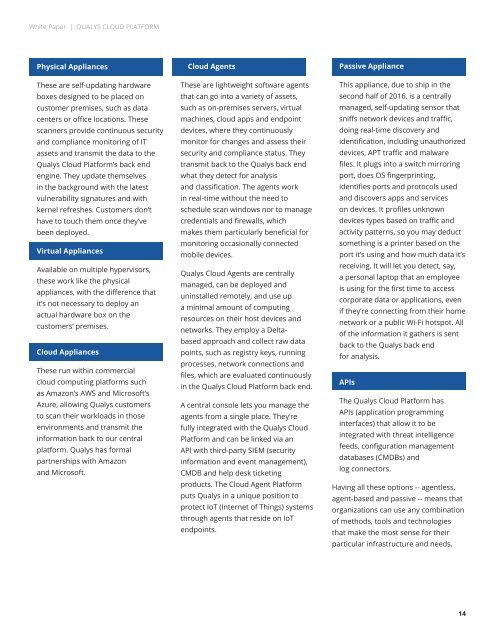Qualys Cloud Platform
qualys-cloud-platform-whitepaper
qualys-cloud-platform-whitepaper
You also want an ePaper? Increase the reach of your titles
YUMPU automatically turns print PDFs into web optimized ePapers that Google loves.
White Paper | QUALYS CLOUD PLATFORM<br />
Physical Appliances<br />
These are self-updating hardware<br />
boxes designed to be placed on<br />
customer premises, such as data<br />
centers or office locations. These<br />
scanners provide continuous security<br />
and compliance monitoring of IT<br />
assets and transmit the data to the<br />
<strong>Qualys</strong> <strong>Cloud</strong> <strong>Platform</strong>’s back end<br />
engine. They update themselves<br />
in the background with the latest<br />
vulnerability signatures and with<br />
kernel refreshes. Customers don’t<br />
have to touch them once they’ve<br />
been deployed.<br />
Virtual Appliances<br />
Available on multiple hypervisors,<br />
these work like the physical<br />
appliances, with the difference that<br />
it’s not necessary to deploy an<br />
actual hardware box on the<br />
customers’ premises.<br />
<strong>Cloud</strong> Appliances<br />
These run within commercial<br />
cloud computing platforms such<br />
as Amazon’s AWS and Microsoft’s<br />
Azure, allowing <strong>Qualys</strong> customers<br />
to scan their workloads in those<br />
environments and transmit the<br />
information back to our central<br />
platform. <strong>Qualys</strong> has formal<br />
partnerships with Amazon<br />
and Microsoft.<br />
<strong>Cloud</strong> Agents<br />
These are lightweight software agents<br />
that can go into a variety of assets,<br />
such as on-premises servers, virtual<br />
machines, cloud apps and endpoint<br />
devices, where they continuously<br />
monitor for changes and assess their<br />
security and compliance status. They<br />
transmit back to the <strong>Qualys</strong> back end<br />
what they detect for analysis<br />
and classification. The agents work<br />
in real-time without the need to<br />
schedule scan windows nor to manage<br />
credentials and firewalls, which<br />
makes them particularly beneficial for<br />
monitoring occasionally connected<br />
mobile devices.<br />
<strong>Qualys</strong> <strong>Cloud</strong> Agents are centrally<br />
managed, can be deployed and<br />
uninstalled remotely, and use up<br />
a minimal amount of computing<br />
resources on their host devices and<br />
networks. They employ a Deltabased<br />
approach and collect raw data<br />
points, such as registry keys, running<br />
processes, network connections and<br />
files, which are evaluated continuously<br />
in the <strong>Qualys</strong> <strong>Cloud</strong> <strong>Platform</strong> back end.<br />
A central console lets you manage the<br />
agents from a single place. They’re<br />
fully integrated with the <strong>Qualys</strong> <strong>Cloud</strong><br />
<strong>Platform</strong> and can be linked via an<br />
API with third-party SIEM (security<br />
information and event management),<br />
CMDB and help desk ticketing<br />
products. The <strong>Cloud</strong> Agent <strong>Platform</strong><br />
puts <strong>Qualys</strong> in a unique position to<br />
protect IoT (Internet of Things) systems<br />
through agents that reside on IoT<br />
endpoints.<br />
Passive Appliance<br />
This appliance, due to ship in the<br />
second half of 2016, is a centrally<br />
managed, self-updating sensor that<br />
sniffs network devices and traffic,<br />
doing real-time discovery and<br />
identification, including unauthorized<br />
devices, APT traffic and malware<br />
files. It plugs into a switch mirroring<br />
port, does OS fingerprinting,<br />
identifies ports and protocols used<br />
and discovers apps and services<br />
on devices. It profiles unknown<br />
devices types based on traffic and<br />
activity patterns, so you may deduct<br />
something is a printer based on the<br />
port it’s using and how much data it’s<br />
receiving. It will let you detect, say,<br />
a personal laptop that an employee<br />
is using for the first time to access<br />
corporate data or applications, even<br />
if they’re connecting from their home<br />
network or a public Wi-Fi hotspot. All<br />
of the information it gathers is sent<br />
back to the <strong>Qualys</strong> back end<br />
for analysis.<br />
APIs<br />
The <strong>Qualys</strong> <strong>Cloud</strong> <strong>Platform</strong> has<br />
APIs (application programming<br />
interfaces) that allow it to be<br />
integrated with threat intelligence<br />
feeds, configuration management<br />
databases (CMDBs) and<br />
log connectors.<br />
Having all these options -- agentless,<br />
agent-based and passive -- means that<br />
organizations can use any combination<br />
of methods, tools and technologies<br />
that make the most sense for their<br />
particular infrastructure and needs.<br />
14


